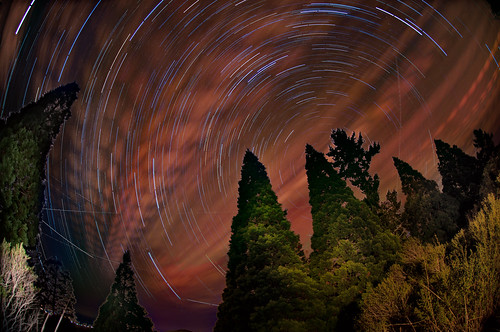
Urban Star Circles, photo by Harold Davis. View this image larger.
Star trails—and star circles—are tough to pull off in an urban environment because of all the ambient light pollution in the environment. You don’t really see the stars when you live in a modern city; for example, most urban dwellers have never seen the Milky Way in all its glory. The relative brightness of the night skies means that the contrast with star light is greatly diminished—making dramatic captures with star trails more difficult. I think this linked night shot of the Golden Gate Bridge works—but only because the quadrant of the sky showing star trails was to a considerable degree isolated from the ambient light of San Francisco, and the foreground reflections of the bridge are also interesting.
Last night seemed crisp and clear. My idea was to go up into Tilden Park and find a north-facing location that was somewhat protected from the ambient urban light. As you can see, as plans often do with night photography this one went somewhat wrong—because of the strength of the overall ambient light even deep in the park, and because of cloud cover.
I shortened the exposure time from what I would usually use in the deep night, and made 47 exposures, each one at 90 seconds, f/2.8 and ISO 200 (for a total exposure time of about an hour and ten minutes). In addition, there are a few frames of light painting of the trees in the foreground.
You can see many airplanes flying into (or out of) Oakland or SFO in the bright, night sky. But for me, the most interesting thing about the image is the way the light—from East Bay cities and San Francisco—has formed beams projecting against the high clouds that are in motion. I see the light patterns against the clouds in the sky as almost like the patterns in shadows you can see when you shine a light through Venetian slatted blinds.
Harold Davis
30 Nov 2010From a reader:
Neat photo!
Hey, Harold,
When you go out for long exposures at night, what do you do while waiting all those 90 sec durations. (Is it cold there now?)
Is your camera set up to take them automatically, or do you manually snap each one.
I”ll bet your list would like hearing about those kinds of details!~
😉
My response:
Colder than heck last night. I had many layers on including wool long undies, pile vest, down jacket, pile balaclava etc. I was with a friend, and we chatted about life, the universe, and wikileaks.
Camera is on bulb and an intervalometer does the exposures automatically after the first few for exposure and light painting are done. Lots of info on my blog in previous stories about this stuff, see http://www.digitalfieldguide.com/blog/1413 and the linked stories—more recently this one details sleeping through the exposures! http://www.digitalfieldguide.com/blog/6600
But yeah thanks for the heads up, I’ll try to tell my story a bit more!
Best wishes,
Harold